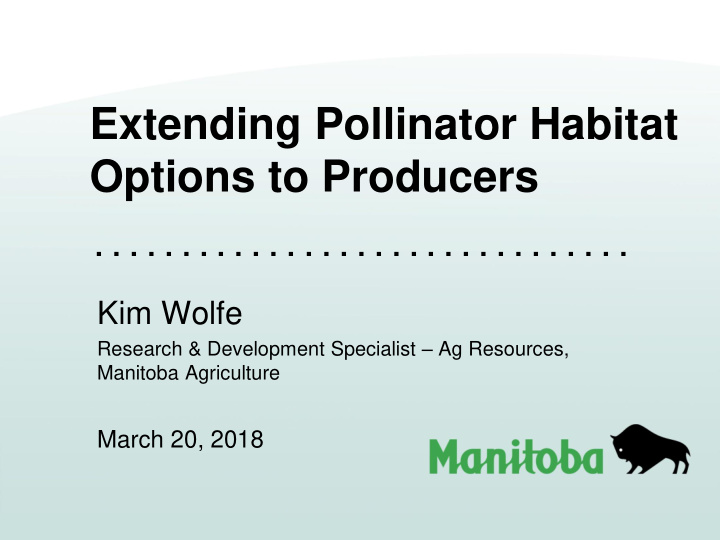



Extending Pollinator Habitat Options to Producers . . . . . . . . . . . . . . . . . . . . . . . . . . . . . . . Kim Wolfe Research & Development Specialist – Ag Resources, Manitoba Agriculture March 20, 2018
Pollinators are Important to Ag • When looking at crops alone, about 35% of global crop production require pollination by native insects, mainly bees and flies • There have been several studies showing that bees increase seed set/yield if there is appropriate habitat nearby a field (Canola – 20% more yield; 1% more oil content (Bartomeus et al., 2014)). • Bee abundance was greatest in canola fields that had more uncultivated land within 750m of field edges; seed set was higher in fields with higher bee abundance (Morandin & Winston, 2006)
Pollinators on the decline • Researchers have found that pollinator numbers are declining • Due to pesticide use, habitat loss, spread of pests and disease • One solution to the decline is to create more habitat • Developing seed mixes for pollinator habitat is difficult • Need to provide food and shelter (variety of species) to support a variety of pollinators • Need plants to establish (soil conditions, moisture), time/labour, costs involved…
Extension at MBFI • Opportunity for extension and demonstrate current pollinator habitat mixes to producers at Manitoba Beef & Forage Initiatives (MBFI) • Two programs being promoted in MB – Syngenta Canada – General Mills/Cheerios • Also planted a pollinator blend composed of native species
Operation Pollinator • International biodiversity program focussed on increasing the number of pollinating insects on commercial farms, and golf courses • Been heavily adopted in Europe (Belgium, France, Germany, Greece, Hungary, Ireland, Italy, Netherlands, Portugal, Spain, Sweden, Switzerland, UK and US) • They have partnered with Soil Conservation Council of Canada to bring the program to western Canada. • In MB, the SCCC has partnered MB Conservation Districts to administer the program.
Operation Pollinator • Targeting 100 producers across 3 prairie provinces (33/province) • Each producer get 1 to 2, 20kg bags of free seed and maintain for 3-5 years • Seed blend composed of non-native species, not very diverse
Operation Pollinator • Planted in two locations at MBFI – Brookdale Farm on June 9, 2017 • Around riparian area that was considered unhealthy due to high amount of invasive species (foxtail barley and Canada thistle) • Site off Hwy 10, previously used to store gravel
Operation Pollinator • Sites sprayed, tilled, seed broadcast with quad seeder (increased recommended rate), harrowed, no maintenance…so far
Operation Pollinator • Clovers and phacelia established well • Although non-native species & not that diverse, it was easy to establish, little labour, low cost, low maintenance, is attracting pollinators • Could improve blend by adding species to increase diversity?
Prairie Originals Seed Mix • Planted a native seed mix from Prairie Originals in early June • Diverse - 3 grass species; 14 forb species • Small area in front of the new shop (500m 2 ) • Tilled, sprayed twice, harrowed, rolled/packed, seed mixed with wet peat moss, hand seeded, rolled again.
Prairie Originals Seed Mix Grasses: Big Bluestem Andropogon gerardii Switchgrass Panicum virgatum Slough Grass Beckmannia syzigachne Forbs: Wild Iris Iris versicolor Swamp Milkweed Asclepias Incarnata Wild Mint Mentha canadensis Black-eyed Susan Rudbeckia hirta Stiff Goldenrod Solidaga rigida Helenium Helenium autumnale Blue Vervain Verbena hastata Culver’s Root Veronicastrum virginicum Turtlehead Chelone glabra Joe Pye Eupatorium sp. Narrowleaf Sunflower Helianthus angustifolius Flat Top White Aster Doellingeria umbellata New England Aster Symphyotrichum novae- angliae Tall Meadow Rue Thalictrum dasycarpum
Prairie Originals Seed Mix • More work, more expensive, dealing with weed issues, ongoing maintenance • Take years to see results, high quality habitat
General Mills / Cheerios • General Mills Cheerios / Xerces Society (invertebrate conservation) • Donated 4 million to protect and restore pollinator habitat on farmland. • Offering free seed for producers, provide a custom mix tailored to producers’ needs • Targeting oat growers who could get up to 160 acres of seed or more • Non-oat growers are also eligible at smaller amount (10-20 acres)
General Mills / Cheerios • Project planned for 2018-21 • MBFI – Johnson Farm (10 acre paddock), meadow/smooth brome • Rejuvenate tame pastures and create pollinator habitat with novel seed mix • What is the best way to establish native seed in pasture?
General Mills / Cheerios • Collect data off site Potential Species Maximilian Sunflower (establishment, photo- Wild Bergamot monitoring, forage Slender beardtongue quality/quantity) Lewis Flax Stiff Goldenrod • Expecting to provide Blackeyed Susan better pollinator Long-headed Coneflower Culvers root foraging habitat that is Evening primrose also valuable for Heliopsis helianthoides grazing and haying Zizia aurea Aster novae angliae
Extension Efforts • Summer field tour, 80 producers • ACC Soil & Water Program, 20 students • MBFI website www.mbfi.ca • Social Media (twitter, facebook) • News media (Manitoba Co-operator)
Public Trust Survey AAFC survey on public trust (2017) with 2000 producers • Over two-thirds of producers (67%) believe that public perceptions about agriculture have at least a moderate impact on their operations and decision-making • Producers implemented a variety of practices in response to external public pressures – reduced their pesticide use (67%), implemented environmental stewardship programs (62%), nutrient management plans (60%) • Cost is main barrier to adoption (73%), level of risk for ROI (63%) www.agr.gc.ca/eng/about-us/publications/agri-info-newsletter/agri-info-newsletter-march-2018
QUESTIONS? Kim Wolfe Manitoba Agriculture 204-871-4373 kim.wolfe@gov.mb.ca
Recommend
More recommend